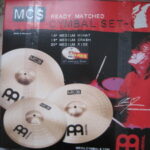Of all the musical pursuits out there, playing the drums is easily one of the most expensive. Even the most basic 4-piece student kit averages about $350.00, and that’s only for the shells, with no hardware or accessories; rather costly when one considers a beginner can obtain a very nice-sounding and playable guitar and amp sold as a package deal for the same money. But of all the necessities for the percussionist, cymbals are the items that they are least likely to be able to afford. Most that come with beginner drumsets are ugly, crack and dent from even moderate use, and sound like an old hubcap.
The reason cymbals are so expensive is because of the time, skill and knowledge involved in their manufacture. They go through a grueling process of casting, stamping, lathing, and hammering by artisans who’ve spent many years perfecting their trade. In other words, you cannot rush the production of a cymbal, or you will only end up making a garbage can lid. Nowadays, thanks to modern technology, computers can be employed to speed up the process while maintaining precision in hammering and lathing, which greatly reduces production costs. While this can never replace the work of experienced cymbalsmiths, it creates affordable cymbals that actually look, sound, and perform close to pro standards! All of the major cymbal manufacturers now have access to this technology, and all of them offer entry-level cymbals of much higher quality than was possible in even the recent past.
As a guitarist, I have played in several bands over the last decade, and have made friends with many skilled and knowledgeable drummers who have taught me a lot about the tools of their trade. As much as I love things with strings, I have always wanted to learn to play drums since I was a baby (there’s something about them that brings out the kid in all of us, no?). But the truth is, for most of my life, this was an economic impossibility. A few years ago, I finally got into a position where I could afford a nice starter set to learn on, but the cymbals that came with it looked and sounded like pie tins. Even the hi-hats sounded like cookie sheets. So, armed with this knowledge of the new generation of student-level cymbals, I went to Guitar Center here in Knoxville, and tried out various offerings from the big 3 manufacturers; Zildjian, Sabian, and Paiste.
The Paiste PST-5 series had a much more musical quality to me than the others. Like the other brands, they are made of a B8 bronze alloy (8% tin and 92% copper), and are a beautiful shiny brown. They will stay that way for a long time with the protective coating Paiste applies to all their cymbals at their German facility, and will not oxidize and get the greenish “patina” some players prefer (especially jazz drummers). Having thick grooves cut into the playing surfaces, their comparatively smooth undersides have beautiful round hammer marks of differing sizes in a pleasing pattern, looking a lot like raindrops beading up on a freshly waxed car.
They sounded a lot more balanced overall than the others, much more professional sounding and less “toy-like”. Their bright sound is characteristic of European cymbals, which some prefer over the more mellow tones of their Turkish counterparts. But best of all, I COULD AFFORD THEM! So thus, I was able to build a pretty impressive collection with little money in a short time!
To get started, I first bought a 3-piece pre-packaged set containing an 18 inch crash/ride and a pair of 13 inch medium hi-hats. I have never been a fan of crash/ride cymbals; they usually perform both jobs okay, but neither one great. But this cymbal does both rather well. Because of its medium-heavy mass, it has a long decay when crashed, as well as some brassy overtones. Its ride quality is mellow and easy, great for quiet passages, whether played on the bell or the body, though the edge sounds a little too washy (Like many crash/rides). In short, it is a much better ride cymbal than a crash.
The 13 inch hi-hats (medium-weight top cymbal with a heavy bottom) were very nice for quieter playing and for funk-style grooves. They had a nice pronounced “chick” when closed with the pedal, produced a really nice “bark” when closed after being struck, and made a smooth, consistent “hiss” when played slightly open. I rather enjoy the sound these make when just closing and opening them with the left foot, without sticking, as marching band cymbals are struck together, playing paradiddles between them and the bass drum. The only downside I see with these beauties is that the small bells mean they’re not very loud, a big limitation when playing hard rock, punk or metal. In fact, the set is probably better suited for jazz, R&B; or light rock.
And, of course, since loud electric music is what I normally play, I had to find some louder cymbals. At least I now had the basic tools I needed to study syncopation and ostenatos, so I could really take my time building my cymbal choir, and do it right. My next step was to find a good fast crash cymbal for accents and punctuation.
The helpful clerk at Guitar Center offered me the 14 inch PST-5 thin crash; a loud, brash, and yet very musical cymbal that performs like a champ! It has a medium sustain, and a very washy stick sound. Performing short crescendo mallet rolls on this thing makes a nice, quick swell. It can also be used for an aggressive, punky-sounding timekeeper in lieu of a ride cymbal or hats, but my favorite technique for this one is the choke (grabbing the edge immediately after striking it), especially when doubled with a bass drum punch. This 14 inch crash rivals its more expensive cousins in sound and performance, is probably my favorite overall. And it only cost me about $65.00!
Next, I needed a nice, loud ride cymbal, so I went back and tried the 20 inch Rock Ride, and WOW, what a ride! This thing is very heavy, and it’s huge, unlathed bell sounds like a hammer striking an anvil. It rings and pings forever, my only beef being that it can get roaring pretty loud if you’re not careful. It is definitely not designed for quiet passages (that’s what the 18 inch crash/ride is for). The edges play very nicely, giving a washy sound with almost no attack at all, but, once again, can easily get out of control volumewise if you’re not paying attention. The body, almost exactly midway between the edge and the bell, is a very sweet spot for me, because it produces a nice attack (especially with a nylon-tip stick) with a more controlled volume and a moderately long decay. A favorite trick of mine here is to do almost a buzz roll kind of ride with a nylon-tipped stick, where it makes a sizzling sound, almost like rain hitting a tin roof. In spite of its limitations, it is probably the most expressive, versatile cymbal I own next to my hi-hats.
Next cymbals I purchased were the 16 inch thin crash and the 18 inch thin crash. Both are very explosive and bright. They have washy stick sounds and a hint of silvery sparkle, like marching band cymbals. The 16 inch sounds better when choked, as the 18 inch still emits a lot of overtones after it is silenced. The 18 inch, however, is the clear winner in the mallet roll contest, producing a long, swelling crescendo that starts out almost bassy and ends like a giant wave crashing onto a lonely beach at midnight. Although not normally done on crash cymbals, sometimes I like to play the bells on these two for quieter movements, often playing gentle paradiddles between the two to simulate the sound of a light forest rain.
Now I needed some nice, loud hats to penetrate the wall of noise a rock band makes, so I got some PST-5 14 inch hats (medium top/medium heavy bottom). Although rated as “mediums”, both cymbals are much thicker and heavier than their 13 inch kinfolk. These things are explosive, because they have the same giant, unlathed bell of its big brother, the 20 inch rock ride. These bark like a German shepherd, and have a loud, penetrating “chick” sound when pedaled closed.
These are the most expressive hats of the 2 sets I bought, giving a huge array of sounds ranging from an staccato click if played while tightly closed, to a massive hurricane when struck fully opened, with infinite sonic variations in between. The bell of the top cymbal can even be played like a miniature ride cymbal when they are open, sounding kind of like a small piece of iron. It sounds especially cool when struck with the butt end of the stick. The only limitations to these big, heavy beauties is that they are indeed loud; not too useful for light jazz, country, R&B; and other drumming styles that favor nuances over power.
Finally, I got 2 more for special effects. First, I got a 10 inch splash, a neat little cymbal that works well for accents and punches. It has a very bright, airy sound with a very quick decay. When choked, it really shuts up quick! Splashes aren’t very versatile, but they are nice to have when you need a short, attention-getting accent during a quiet passage. This little chestnut sounds just like the splash at the end of Robert Palmer’s “Bad Case of Loving You (Doctor, Doctor)”.
Last, but definitely not least, I got an 18 inch China cymbal, probably the most visually stunning of the group. It has a small, smooth bell, a slightly bowl-shaped body, and a smooth-as-glass, curved, upturned edge, with hundreds of beautiful, hologram-like round hammer marks, all interconnecting in a marvelous pattern. It is the only cymbal in the PST-5 series that has thick grooves lathed on the underside as well as the top, unlike its brethren, whose bottoms have micro-fine grooves and relatively few hammer marks.
This piece of metal has a trashy, yet very musical, sound when struck with a drumstick, but a breathy, almost gonglike sound when hit with a felt mallet. It makes an interesting swell when rolled with mallets. The tiny, flat, cup-shaped bell makes great sounding ride patterns, but its diminutive size makes it hard to hit consistently. If mounted upside-down, it makes a very loud, explosive crash with a quick decay, but I prefer mounting it bell-side-up, because it is much more versatile to me that way. The edge sounds very washy and trashy with plenty of sustain, and the body makes a nice ping, sounding almost like somebody shooting BBs at a stop sign.
I’ll admit that I bought them mostly because they were affordable (but not cheap; there’s a difference). Their musicality was a nice surprise, but their DURABILITY is why I’d recommend them to anyone! I have owned mine for several years now, and have played the hell out of them, and they have not even developed hairline cracks. I have played with many “drummers-on-a-budget” over the years, and I have watched them destroy Zildjian ZBTs and Sabian B8 Pros. These have stood up well under my heavy, Neanderthal hands while trying to learn proper sticking techniques. I think these cymbals are one of the best investments I ever made, because someday when I can afford to buy professional-grade cymbals from Paiste’s Signature series, I am quite sure I will be able to pass these beauties down to my nieces or nephews should they ever want to learn to play. After all, if they start on good, solid, gear that looks and sounds great (and lasts), odds are they’ll stick with it, and become great drummers themselves someday!



